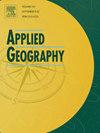中国土地利用弹性与效率的整合:空间格局分析、对可持续发展目标的差异影响及适应性管理策略
IF 4
2区 地球科学
Q1 GEOGRAPHY
引用次数: 0
摘要
鉴于日益增加的内部和外部风险,以及土地资源供需动态的冲突,仅仅注重复原力或效率证明是不够的。为了适应复杂变化和解决资源过剩问题,本研究量化了中国31个省份的土地利用弹性(LUR)和土地利用效率(LUE)。利用耦合协调模型探讨了二者的相互关系。该分析还使用Pearson相关系数模型评估了他们对可持续发展目标(SDGs)的不同反应。结果表明,中国的LUR从2000年的0.2656上升到2022年的0.3901,而LUE同期从0.7510上升到1.0845。LUR和LUE的功能阻力与流动转化呈正相关。此外,与仅关注复原力或效率的模型相比,lue - lue耦合协调更符合可持续发展目标。lue - lue自适应管理优化区分为6种类型:高协同、高中心性、辐射驱动、辐射停滞、辐射抑制和低固化。这些发现增强了我们对土地利用系统动态性质的理解,并为实现高质量、安全和协同发展的努力提供了支持。本文章由计算机程序翻译,如有差异,请以英文原文为准。
Integration of land use resilience and efficiency in China: Analysis of spatial patterns, differential impacts on SDGs, and adaptive management strategies
Given the increasing internal and external risks, as well as the conflicting supply-demand dynamics of land resources, focusing solely on resilience or efficiency proved insufficient. To adapt to complex changes and address resource surpluses, this study quantified land use resilience (LUR) and land use efficiency (LUE) across 31 provinces in China. Their interconnected relationship was explored using the coupling coordination model. The analysis also assessed their varied responses to the Sustainable Development Goals (SDGs) using the Pearson correlation coefficient model. Results showed that LUR in China increased from 0.2656 in 2000 to 0.3901 in 2022, while LUE rose from 0.7510 to 1.0845 during the same period. A positive correlation was observed between functional resistance and flow transformation in LUR and LUE. Furthermore, the LUR-LUE coupling coordination aligned more closely with the SDGs than models focusing solely on resilience or efficiency. LUR-LUE adaptive management optimization zones were categorized into six types: high-level synergy, high-level centrality, radiation-driven, radiation stagnation, radiation depression, and low-level solidification. These findings enhance our understanding of the dynamic nature of land use systems and support efforts toward high-quality, secure, and synergistic development.
求助全文
通过发布文献求助,成功后即可免费获取论文全文。
去求助
来源期刊

Applied Geography
GEOGRAPHY-
CiteScore
8.00
自引率
2.00%
发文量
134
期刊介绍:
Applied Geography is a journal devoted to the publication of research which utilizes geographic approaches (human, physical, nature-society and GIScience) to resolve human problems that have a spatial dimension. These problems may be related to the assessment, management and allocation of the world physical and/or human resources. The underlying rationale of the journal is that only through a clear understanding of the relevant societal, physical, and coupled natural-humans systems can we resolve such problems. Papers are invited on any theme involving the application of geographical theory and methodology in the resolution of human problems.
 求助内容:
求助内容: 应助结果提醒方式:
应助结果提醒方式:


